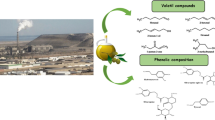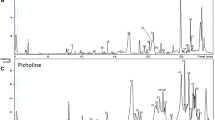Abstract
This paper reports the quality indices, the volatile components, phenolic compounds and the oxidative stability of monovarietal Tunisian cultivar (cv. Neb Jmel) extra-virgin olive oils cultivated in eight regions. Headspace solid-phase microextraction and HPLC–DAD were applied to analyze and quantify the volatile and phenolic compounds of the obtained extra-virgin olive oils. Twenty compounds have been identified and quantified, revealing the complex profile of Neb Jmel EVOO, composed, in order of abundance, by secoiridoids, phenolic alcohols, lignans, flavonoids and phenolic acids. A total of 40 volatile compounds belonging mainly to esters, aldehydes, ketones, aliphatic alcohols and hydrocarbons were determined. Significant differences in the proportions of volatile and phenolic constituents of oils from different geographical origins were observed. The major volatile component was the C6 aldehyde (hexanal and (E)-2-hexenal) fraction, whose content was highly variable between the areas studied. The content of (E)-2-hexenal ranged from 50.9 % in the Melloulech EVOO to approximately 39.8 % for El-Ala EVOO.




Similar content being viewed by others
References
DGPA/ONH (1996) L’oléiculture tunisienne. Olivae 61:12–20
Ben Mansour A, Flamini G, Ben Selma Z, Le Dréau Y, Artaud J, Abdelhedi R, Bouaziz M (2015) Olive oil quality is strongly affected by cultivar, maturity index and fruit part: chemometrical analysis of volatiles, fatty acids, squalene and quality parameters from whole fruit, pulp and seed oils of two Tunisian olive cultivars. Eur J Lipid Sci Technol 117:976–987
Boskou D (1996) Olive oil: chemistry and technology. AOCS Press, Champaign
Kiritsakis AK (1998) Flavor components of olive oil. J Am Oil Chem Soc 75:673–681
Dabbou S, Issaoui I, Esposto S, Sifi S, Taticchi A, Servili M, Montedoro GF, Hammami M (2009) Cultivar and growing area effects on minor compounds of olive oil from autochthonous and European introduced cultivars in Tunisia. J Sci Food Agric 89:1314–1325
Angerosa F (2002) Influence of volatile compounds on virgin olive oil quality evaluated by analytical approaches and sensor panels. Eur J Lipid Sci Technol 104:639–660
Angerosa F, Basti C, Vito R (1999) Virgin olive oil volatile compounds from lipoxygenase pathway and characterization of some Italian cultivars. J Agric Food Chem 47:836–839
Campeol E, Flamini G, Chericoni S, Catalano S, Cremonini R (2001) Volatile compounds from three cultivars of Olea europea from Italy. J Agric Food Chem 49:5409–5411
Ammar S, Zribi A, Ben-Mansour A, Ayadi M, Abdelhedi R, Bouaziz M (2014) Effect of processing systems on the quality and stability of Chemlali olive oils. J Oleo Sci 63:311–323
Di Giovacchino L, Costantini N, Serraiocco A, Surricchio G, Basti C (2001) Natural antioxidants and volatile compounds of virgin olive oils obtained by two or three-phases centrifugal decanters. Eur J Lipid Sci Technol 103:279–285
Ben-Temime S, Taamalli W, Baccouri B, Abaza L, Ben-Miled D, Zarrouk M (2006) Changes in olive oil quality of Chétoui variety according to origin of plantation. J Food Lipids 13:88–99
Casale M, Armanino C, Cosolino C, Forina M (2007) Combining information from headspace mass spectrometry and visible spectroscopy in the classification of Ligurian olive oils. Anal Chim Acta 589:59–95
Taamalli A, Roman DA, Zarrouk M, Segura-Carretero A, Fernandez-Gutierrez A (2012) Classification of Chemlali accessions according to the geographical area using chemometric methods of phenolic profiles analysed by HPLC-ESI-TOF-MS. Food Chem 132:561–566
Tura D, Gigliotti C, Pedo S, Failla O, Bassi D, Serraiocco A (2007) Influence of cultivar and site of cultivation on levels of lipophilic and hydrophilic antioxidants in virgin olive oils (Olea europea L) and correlations with oxidative stability. Sci Hortic 112:108–119
Cerretani L, Salvador MD, Bendini A, Fregapane G (2008) Relationship between sensory evaluation performed by Italian and Spanish official panels and volatile and phenolic profiles of virgin olive oils. Chem. Percept. 1:258–267
Rosignoli P, Fuccelli R, Fabiani R, Servili M, Morozzi G (2013) Effect of olive oil phenols on the production of inflammatory mediators in freshly isolated human monocytes. J Nutr Biochem 24:1513–1519
Ouni Y, Taamalli A, Maria Gómez-Caravaca A, Segura-Carretero A, Fernandez-Gutiérrez A, Zarrouk M (2011) Characterisation and quantification of phenolic compounds of extra-virgin olive oils according to their geographical origin by a rapid and resolutive LC–ESI-TOF MS method. Food Chem 127:1263–1267
International Olive Council (IOC) (2015) Trade standard applying to olive oils and olive pomace oils. COI/T, 15/NC n◦ 3 Rev 7. Principe de Vergara, 154, 28002, Madrid, Spain
Minguez-Mosquera MI, Gandul-Rojas B, Montano-Asquerino A, Garrido-Fernandez J (1991) Determination of chlorophylls and carotenoids by HPLC during olive lactic fermentation. J Chromatogr 585:259–266
Chtourou M, Gargouri B, Jaber H, Bouaziz M (2013) Comparative study of olive quality from Chemlali Sfax Arbequina cultivated in Tunisia. Eur J Lipid Sci Technol 115:631–640
Gargouri B, Ammar S, Zribi A, Ben Mansour A, Bouaziz M (2013) Effect of growing region on quality characteristics and phenolic compounds of Chemlali extra-virgin olive oils. Acta Physiol. Plant. 35:2801–2812
Dridi-Gargouri O, Kallel-Trabelsi S, Bouaziz M, Abdelhèdi R (2013) Synthesis of 3-O-methylgallic acid a powerful antioxidant by electrochemical conversion of syringic acid. Biochim Biophys Acta 1830:3643-3649
Ben Mansour A, Porter EA, Kite GC, Simmonds MSJ, Abdelhedi R, Bouaziz M (2015) Phenolic profile characterization of Chemlali olive stones by liquid chromatography-ion trap mass spectrometry. J Agric Food Chem 63:1990–1995
Adams RP (1995) Identification of essential oil components by gas chromatography/mass spectroscopy. Allured, Carol Stream
Flamini G, Cioni PL, Morelli I (2003) Volatiles from leaves, fruits, and virgin oil from Olea Europaea Cv. Olivastra Seggianese from Italy. J Agric Food Chem 51:1382–1386
Hannachi H, Msallem M, Ben-Elhadj S, El Gazzah M (2007) Influence of geographical location on the agronomic potential and technology of olive (Olea europaea L.) in Tunisia. C. R. Biologies 330:135–142
Ouni Y, Flamini G, Issaoui M, Ben-Youssef N, Pier-Luigi C, Hammami M, Douja D, Zarrouk M (2011) Volatile compounds and compositional quality of virgin olive oil from Oueslati variety: influence of geographical origin. Food Chem 124:1770–1776
Kiritsakis AK, Christie WW (2000) Analysis of edible oils. In: Harwood J, Aparicio R (eds) Handbook of Olive Oil Analysis and Properties. Aspen, Gaithersburg, pp 129–158
Paz Romero M, Jesus Tovar M, Ramo T, José Motilva M (2003) Effect of crop season on the composition of virgin olive oil with protected designation of origin ‘Les Garrigues’. J Am Oil Chem Soc 80:423–430
Ben Youssef N, Zarrouk W, Carrasco-Pancorbo A, Ouni Y, Segura-Carretero A, Fernandez-Gutierrez A, Daoud D, Zarrouk M (2009) Effect of olive ripeness on chemical properties and phenolic composition of chetoui virgin olive oil. J Sci Food Agric 90:199–204
Cartoni GP, Coccioli F, Jasionowska R, Ramires D (2000) HPLC analysis of the benzoic and cinnamic acids in edible vegetable oils. Ital J Food Sci 12:163–173
Krichène D, Taamalli W, Daoud D, Salvador MD, Fregapane G, Zarrouk M (2007) Phenolic compounds, tocopherols and other minor components in virgin olive oils of some Tunisian varieties. J Food Biochem 31:179–194
Montedoro GF, Servilli M, Baldioli M, Miniati E (1992) Simple and hydrolyzable phenolic compounds in olive oil. 1. Their extraction, separation, and quantitative and semiquantitative separation and evaluation by HPLC. J Agric Food Chem 40:1571–1576
Papadopoulos GK, Boskou D (1991) Antioxidant effect of natural phenols on olive oil. JACS 68:669–671
Gutierrez F, Arnaud T, Garrido A (2001) Contribution of polyphenols to the oxidation stability of virgin olive oil. J Sci Food Agric 81:1–8
Baccouri O, Bendini A, Cerretani L, Guerfel M, Baccouri B, Lercker G, Zarrouk M, Ben-Miled D (2008) Comparative study on volatile compounds from Tunisian and Sicilian monovarietal virgin olive oils. Food Chem 111:277–296
Erickson RP, Covey E (1980) On the singularity of taste sensations: what is a taste primary. Physiol Behav 25:527–533
Ammar S, Zribi A, Gargouri B, Flamini G, Bouaziz M (2014) Effect of addition of olive leaves before fruits extraction process to some monovarietal Tunisian extra-virgin olive oils using chemometric analysis. J Agric Food Chem 50:835–839
Andreas, H., Arnd, H.: Flavor profiling of different olive oils with rancidity-monitoring by thermal extraction TGC/MS. Glob. Anal. Solut. pp. 1–10 (2000)
Cavalli JF, Fernandez X, Lizzani-Cuvelier L, Loiseau AM (2004) Characterization of volatile compounds of French and Spanish virgin olive oils by HS-SPME: identification of quality-freshness markers. Food Chem 88:151–157
Schwab W, Davidovich-Rikanati R, Lewinsohn E (2008) Biosynthesis of plant-derived flavor compounds. Plant J. 54:712–732
Angerosa F, d’Alessandro N, Basti C, Vito R (1998) Biogeneration of Volatile Compounds in Virgin Olive Oil: their Evolution in Relation to Malaxation Time. J Agric Food Chem 46:2940–2944
Salas JJ, Sanchez J (1999) The decrease of virgin olive oil flavour produced by high malaxation temperature is due to the inactivation of hydroperoxide lipase. J Agric Food Chem 47:809–813
Servili M et al (2000) Volatile compounds of virgin olive oil evaluated by solid-phase microextraction: an Application in the discrimination of virgin olive oils according to the cultivar and area. In: Lanzotti V, Taglialatela-Scafati O (eds) Flavour and Fragrance Chemistry, vol 46. Kluwer Academic Publishers, Dordrecht, pp 211–220
Servili M, Baldioli M, Beglimini AL, Selvaggini R, Montedoro GF (2000) The phenolic and volatile compounds of virgin olive oil: Relationships with the endogenous oxidoreductases during the mechanical oil extraction process. In: Lanzotti V, Taglialatela- Scafati O (eds) Flavour and Fragrance Chemistry, Kluwer, The Netherlands, pp 163–173
Cecchi T, Alfei B (2013) Volatile profiles of Italian monovarietal extra virgin olive oils via HS-SPME-GC-MS: newly identified compounds, flavors molecular markers, and terpenic profile. Food Chem 141:2025–2035
Shaker MA, Azza AA (2013) Relationship between volatile compounds of olive oil and sensory attributes. Food Res Int 20:197–204
Mateos R, Cert A, Pérez-Camino MC, Garcia MJ (2004) Evaluation of virgin olive oil bitterness by quantification of secoiridoid derivatives. J Am Oil Chem Soc 81:71–75
Andrewes P, Bush JLHC, De Joode T, Groeneken A, Alexandre H (2003) Sensory properties of virgin olive oil polyphenols: identification of deacetoxy-ligstroside aglycon as a key contributor to pungency. J Agric Food Chem 51:1415–1420
Ben Mansour A, Gargouri B, Flamini G, Bouaziz M (2015) Effect of agricultural sites on differentiation between Chemlali and Neb Jmel olive oils. J Oleo Sci 64(4):381–392
Acknowledgments
The authors would like to thank the Ministry of Higher Education and Scientific Research of Tunisia (Contrat Programme LR14ES08), for their support of this research work. They also wish to extend their thanks to Mrs. Leila MAHFOUDHI, an English teacher at the Sfax Faculty of Science, for having proofread this paper.
Author information
Authors and Affiliations
Corresponding author
Ethics declarations
Conflict of interest
The authors declare that they have no conflict of interest.
Compliance with ethics requirements
This article does not contain any studies with human or animal subjects.
Rights and permissions
About this article
Cite this article
Ben Mansour, A., Chtourou, F., Khbou, W. et al. Phenolic and volatile compounds of Neb Jmel olive oil cultivar according to their geographical origin using chemometrics. Eur Food Res Technol 243, 403–418 (2017). https://doi.org/10.1007/s00217-016-2754-5
Received:
Revised:
Accepted:
Published:
Issue Date:
DOI: https://doi.org/10.1007/s00217-016-2754-5




